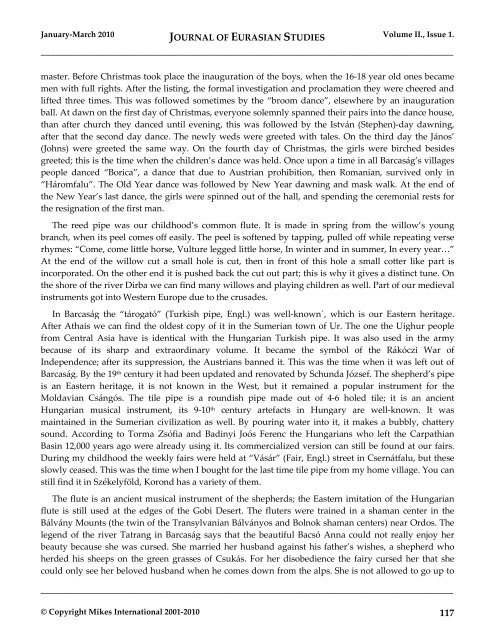EurasianStudies_0110..
EurasianStudies_0110..
EurasianStudies_0110..
You also want an ePaper? Increase the reach of your titles
YUMPU automatically turns print PDFs into web optimized ePapers that Google loves.
January-March 2010 JOURNAL OF EURASIAN STUDIES Volume II., Issue 1.<br />
_____________________________________________________________________________________<br />
master. Before Christmas took place the inauguration of the boys, when the 16-18 year old ones became<br />
men with full rights. After the listing, the formal investigation and proclamation they were cheered and<br />
lifted three times. This was followed sometimes by the “broom dance”, elsewhere by an inauguration<br />
ball. At dawn on the first day of Christmas, everyone solemnly spanned their pairs into the dance house,<br />
than after church they danced until evening, this was followed by the István (Stephen)-day dawning,<br />
after that the second day dance. The newly weds were greeted with tales. On the third day the János’<br />
(Johns) were greeted the same way. On the fourth day of Christmas, the girls were birched besides<br />
greeted; this is the time when the children’s dance was held. Once upon a time in all Barcaság’s villages<br />
people danced “Borica”, a dance that due to Austrian prohibition, then Romanian, survived only in<br />
“Háromfalu”. The Old Year dance was followed by New Year dawning and mask walk. At the end of<br />
the New Year’s last dance, the girls were spinned out of the hall, and spending the ceremonial rests for<br />
the resignation of the first man.<br />
The reed pipe was our childhood’s common flute. It is made in spring from the willow’s young<br />
branch, when its peel comes off easily. The peel is softened by tapping, pulled off while repeating verse<br />
rhymes: “Come, come little horse, Vulture legged little horse, In winter and in summer, In every year…”<br />
At the end of the willow cut a small hole is cut, then in front of this hole a small cotter like part is<br />
incorporated. On the other end it is pushed back the cut out part; this is why it gives a distinct tune. On<br />
the shore of the river Dirba we can find many willows and playing children as well. Part of our medieval<br />
instruments got into Western Europe due to the crusades.<br />
In Barcaság the “tárogató” (Turkish pipe, Engl.) was well-known´, which is our Eastern heritage.<br />
After Athais we can find the oldest copy of it in the Sumerian town of Ur. The one the Uighur people<br />
from Central Asia have is identical with the Hungarian Turkish pipe. It was also used in the army<br />
because of its sharp and extraordinary volume. It became the symbol of the Rákóczi War of<br />
Independence; after its suppression, the Austrians banned it. This was the time when it was left out of<br />
Barcaság. By the 19 th century it had been updated and renovated by Schunda József. The shepherd’s pipe<br />
is an Eastern heritage, it is not known in the West, but it remained a popular instrument for the<br />
Moldavian Csángós. The tile pipe is a roundish pipe made out of 4-6 holed tile; it is an ancient<br />
Hungarian musical instrument, its 9-10 th century artefacts in Hungary are well-known. It was<br />
maintained in the Sumerian civilization as well. By pouring water into it, it makes a bubbly, chattery<br />
sound. According to Torma Zsófia and Badinyi Joós Ferenc the Hungarians who left the Carpathian<br />
Basin 12,000 years ago were already using it. Its commercialized version can still be found at our fairs.<br />
During my childhood the weekly fairs were held at “Vásár” (Fair, Engl.) street in Csernátfalu, but these<br />
slowly ceased. This was the time when I bought for the last time tile pipe from my home village. You can<br />
still find it in Székelyföld, Korond has a variety of them.<br />
The flute is an ancient musical instrument of the shepherds; the Eastern imitation of the Hungarian<br />
flute is still used at the edges of the Gobi Desert. The fluters were trained in a shaman center in the<br />
Bálvány Mounts (the twin of the Transylvanian Bálványos and Bolnok shaman centers) near Ordos. The<br />
legend of the river Tatrang in Barcaság says that the beautiful Bacsó Anna could not really enjoy her<br />
beauty because she was cursed. She married her husband against his father’s wishes, a shepherd who<br />
herded his sheeps on the green grasses of Csukás. For her disobedience the fairy cursed her that she<br />
could only see her beloved husband when he comes down from the alps. She is not allowed to go up to<br />
_____________________________________________________________________________________<br />
© Copyright Mikes International 2001-2010 117

















